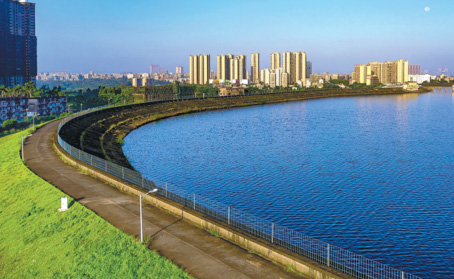Optimizing water resources a top priority
With the goal of bolstering ecological civilization, Zhanjiang city in Guangdong province is comprehensively advancing its role in the Guangdong water resources allocation project in the Beibu Gulf region, ensuring land use while optimizing water resources to provide strong support for high-quality leapfrog development.
As the largest water diversion project in Guangdong, the 61.46 billion yuan ($8.48 billion) project covers 490.33 kilometers of pipes on a main line and three branch lines. The main line stretches 201.68 km, while the branches total 288.65 km, including the 168.85-km Zhanjiang branch.
The project, which draws water from the main stream of the Xijiang River in Yunfu and ultimately transports it to the Dashuiqiao Reservoir in Xuwen county, is expected to commence operation by 2030.
Once completed, the Zhanjiang branch will fundamentally solve the long-standing drought problem on the Leizhou Peninsula, increase the regional water supply capacity, improve the regional water ecological environment and support high-quality development of the regional economy and society.
The Zhanjiang branch commenced construction in April 2023, with a total investment of 21.16 billion yuan. It has a designed water diversion flow of 110 cubic meters per second, and an average annual water diversion volume of 2.08 billion cu m. The project focuses on urban and rural domestic and industrial water supply, while also considering agricultural irrigation.

Dashuiqiao Reservoir in Xuwen county is set to store water delivered by Guangdong's water resources allocation project around the Beibu Gulf. LUO LINZHU/FOR CHINA DAILY
Zeng Jinze, mayor of Zhanjiang, said that by mid-February, cumulative investment in the Zhanjiang branch project had reached 3.36 billion yuan, and construction had commenced at all 22 construction sites, with 29.75 km of pipelines completed.
To ensure full utilization of Xijiang River water after its introduction, Zhanjiang has formulated a plan to finish several supportive water network projects by 2028.
At present, the city is building a water supply and storage network project for the Leizhou Peninsula, connecting 397 reservoirs, 1,334 mountain ponds and 10,078 small ponds in a tailored manner to form an interconnected water supply and storage network.
Zhanjiang is also coordinating the integrated urban and rural water supply to build 79 large-scale surface water supply plants and expand or replace 21,263 km of water supply pipelines, with a total water supply capacity reaching 3.32 million metric tons per day. By the end of 2025, the proportion of large-scale water supply in the entire city is expected to exceed 80 percent.
Furthermore, Zhanjiang is accelerating completion of reinforcement projects for 171 vulnerable reservoirs throughout the city. Currently, it is protecting the drinking water source of the Dashuiqiao Reservoir, striving to upgrade quality of the reservoir to Class II. The city is also tapping into surrounding tourism resources to develop the reservoir into a provincial-level water conservancy scenic area by 2025.
In addition, Zhanjiang has built a number of distinctive riverside greenways such as the Binhu Park Greenway, Nandiao River Greenway and Anpu River Greenway and launched 12 river and lake ecological restoration projects, with a total investment exceeding 6 billion yuan.



 Print
Print Mail
Mail

